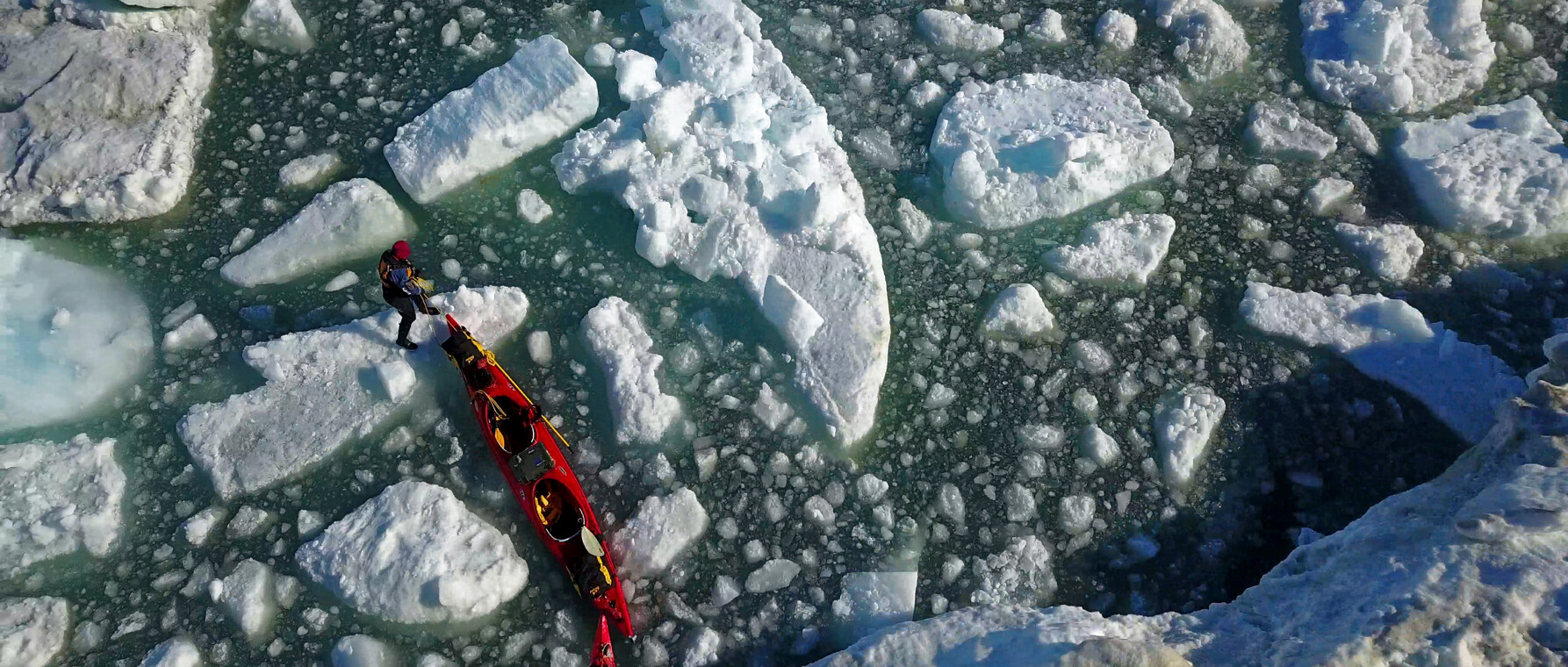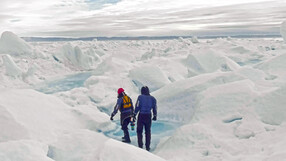Melting Away
The Arctic feels the impact of rapid climate change

In the summer of 2017, shortly after receiving a PhD in applied mathematics from Harvard, Christopher Horvat ventured to the Nares Strait—a narrow passageway between the world’s two northernmost landmasses, Greenland and Ellesmere Island. A sea ice expert, Horvat focuses especially on floating chunks of frozen seawater called “ice floes.” He’d made his way to this remote region—only about 700 kilometers from the North Pole—to get a close-up view of the objects he’d been studying, on an abstract basis, for about five years. The Nares Strait joins the Arctic Ocean to the Atlantic, and every summer powerful currents push sea ice southward past craggy peaks on both the eastern and western shores.
Horvat, a NOAA Climate and Global Change Postdoctoral Fellow and a Voss Postdoctoral Fellow in Environment and Society at Brown University, had come for research purposes, and his work was the main subject of the forthcoming documentary, “Enduring Ice,” which was being filmed that summer. The original plan was for Horvat and his colleagues to cover more than 500 kilometers by kayak in 30 days, traveling through what he calls, in view of the pronounced Arctic warming, “the last refuge for sea ice” or the place that such ice was expected to endure the longest. He figured there might not be many opportunities in the future because “our ability to see and feel the consequences of rapid Arctic change may be melting away.”
But the group’s ambitious plans were not realized. Large ice floes, up to tens of kilometers wide, normally clog the upper portion of the strait, leaving relatively uncluttered water below that’s suitable for kayaking. When the team arrived in 2017, the floes were too small to create a dam. Instead, the strait was filled with fast-moving ice chunks, which made it too dangerous for transit by kayak, especially with the prevailing hurricane-force winds. Horvat and the others had to pull their kayaks, weighing about 300 pounds each, from the shore over the ice, snow, and pools of melting water. They could only manage a few kilometers a day, covering about 100 kilometers overall in a grueling portage. Horvat and the rest of the Enduring Ice team were victims, ironically, of ice that had not endured—a problem Horvat anticipated in the future, not realizing it had already happened.
From the Ethereal to the Tangible
The whole scenario—hauling kayaks far above the Arctic Circle, pitching tents on ice and snow—was rather implausible for anyone who knew Horvat before he’d arrived at Harvard. Prior to entering graduate school, he had no interest in ice and had never even gone camping. At the University of Pittsburgh, he was an undergraduate math major preoccupied with esoteric problems in number theory such as the “lonely runner conjecture,” which concerns the spacing of runners moving at different speeds around a circular track. He became a bit less ethereal in graduate school by entering an applied math program, taking a further step towards the tangible at the suggestion of his Harvard advisor, Eli Tziperman, who felt he might find an interesting research problem related to sea ice—a subject Tziperman had been looking into for more than a decade.
In the fall of 2012, at the start of his second year at Harvard, Horvat attended a sea ice workshop at the Woods Hole Oceanographic Institution. One lecturer cited the conventional wisdom, which held that Arctic melting depended solely on ice thickness; a floe’s size or width was deemed insignificant. The assertion was offered as a fact, with no evidence to back it up. “Given my training in mathematics, I distrusted statements made without any proof,” Horvat says. “I wondered if floe size might be significant after all, and I decided it would be worth looking at ice on a granular scale.” And that’s how he came upon his thesis topic, “Theory, modeling, and impact of the sea ice floe size distribution.”
The Arctic Ocean is warming dramatically, with sea ice in rapid decline—decreasing in volume by more than 70 percent during the summers since 1972. This, according to Horvat, is “the fastest, most important change in the climate over the last 40-plus years,” and it is helping to warm the rest of the world, too. The general picture is rather simple: When sunlight hits ice and snow, almost all of its energy is reflected back into space. The open ocean, on the other hand, absorbs solar energy, warming surface waters in return. That contributes to even more melting—a self-reinforcing loop known as the “ice albedo effect.”
Horvat, of course, was seeking a more refined picture. Most global climate models treated sea ice as a uniform sheet when it’s actually a complex mosaic of pieces spanning a broad range of sizes and thicknesses. If you place a large block of ice in warm water, the ice will melt more quickly when you break it into small pieces, which increases the surface area, thereby facilitating heat transfer. This effect is well-known to earth scientists and thermodynamicists, as well as to bartenders. But it doesn’t have much to do with the melting of ice floes (except for very small ones, less than 30 meters across, according to the conventional view) because the surface area on the top or bottom of the floe is generally so much greater than the area along the sides that it hardly matters whether the floe is 100 meters wide or 100 kilometers.
That argument, however, only tells part of the story. “In real life,” Horvat explains, “the way heat gets to the ice is through swirling ocean currents called eddies.” As to how eddies form, imagine an isolated floe that has undergone some melting. A layer of mostly freshwater will seep underneath (as most of the salt was already discharged into the ocean upon freezing), surrounded on all sides by warmer, denser seawater. The differences in temperature and density create an unstable situation, which drives a circular current running along the edge of the floe. Analyses by Horvat, working in concert with Tziperman and MIT researcher Jean-Michel Campin, showed that eddies transfer heat from the warmer open water to the floe edge, contributing substantially to the melting of floes of all sizes, with smaller ones melting more rapidly. They’d demonstrated, in other words, that floe size was important and should be factored into climate models.
Analyses . . . showed that eddies transfer heat from the warmer open water to the floe edge, contributing substantially to the melting of floes of all sizes, with smaller ones melting more rapidly.
Challenging Assumptions
Horvat’s interests are not limited to ice. He studies links between ice, oceans, and life while trying to determine how the Earth’s natural and human systems interconnect. Some big news came in 2012 when a team of researchers, led by Kevin Arrigo of Stanford, announced the discovery of a giant bloom of photosynthetic microorganisms called “phytoplankton”—about 30 meters deep and more than 100 kilometers across—beneath the ice-covered waters of the Chukchi Sea, just north of the Bering Strait. Until that time, people had likened the region beneath the ice to a desert, assuming that nothing would grow there because ice blocked the sunlight. That belief, Horvat says, turned out to be very wrong.

Several years later, he teamed up with Harvard applied mathematician Sarah Iams, David Rees Jones of Oxford, and colleagues at the UK’s University of Reading to develop a model regarding the timing and initiation of such blooms. Their computations showed that thinning sea ice was responsible for the blooms, allowing enough light to pass through to support photosynthesis. “The thinning of sea ice has led to the potential for sub-ice blooms that can extend as far as the North Pole in June and July, covering nearly a third of the Arctic Basin,” Horvat says. Given that phytoplankton sits at the base of the food chain, this represents a dramatic change in “under-ice ecology,” the full extent of which is not yet known.
Horvat acknowledges that almost all of his work related to ice thickness and floe size is based on mathematical modeling, drawing on observational data when available. “But none of this has been verified yet because it’s very hard, and very expensive, to verify things in the Arctic,” he says. “Icebreakers cost $100,000 per day. You need to get a large number of instruments in place in extremely hard-to-reach settings. We’re now pushing for that to be done, but it won’t happen soon.”
Driven by Curiosity

In the meantime, he’s returning to the Nares Strait later in 2018 with the Enduring Ice team, where he’ll pursue some modest research at much lower cost than an NSF-funded venture. “What we’re doing is tremendously unsafe and wouldn’t be supported by a government agency,” Horvat says. “We’re in the middle of nowhere and weather can be extreme. Plus, there’s polar bears, and we don’t have any guns.”
Many of his peers have trouble picturing Horvat as a rugged Arctic explorer, given that he never was a hands-on, outdoorsy kind of guy. He was, instead, “distinctly egg-headed,” someone who spent most of his time at a computer desk. On the other hand, he says, “Why shouldn’t I do this? I’m young, curious, and have the ability to get up there. The work is interesting to me, and I’m hoping that, someday, it might change the way we think about sea ice.”
Visit the Enduring Ice website for the official project trailer.
Photos by Enduring Ice LLC
Get the Latest Updates
Join Our Newsletter
Subscribe to Colloquy Podcast
Simplecast





